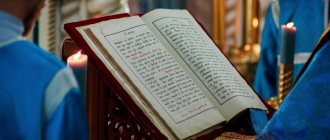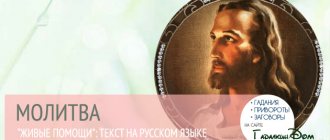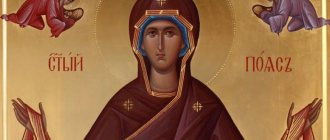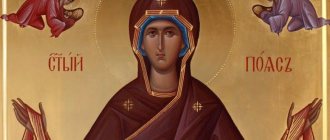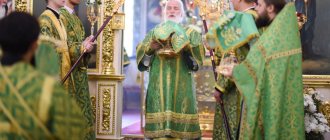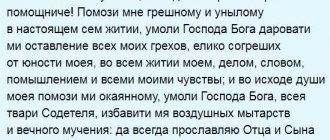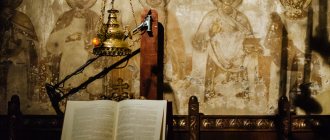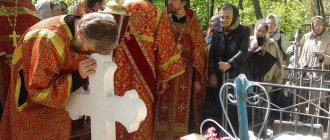“Live help” - what is it?
Psalm 90 is located in the book of Psalms and is used to ask for God's help and salvation. The clergy believe that “Living Help” is a prayer that everyone should know. Most scientists and church ministers are confident that the author of the prayer text is Moses, but there is also an assumption that this is the creation of pagan sages. “Alive in Help” is a prayer that stands out among the fact that it is used not only in Christianity, but also in Hinduism. Traditionally, the prayer text is carried with oneself as a talisman.
How does an image help?
Legends tell about miracles associated with the Belt of the Mother of God. The legendary case of the deliverance of Empress Zoya from demons was not the only one in a series of Divine mercies bestowed on people. First of all, icons depicting a shrine help in healing diseases. The Mother of God can cure both physical and mental illnesses of a person.
However, images of relics have particular power in matters related to childbirth. Since the Middle Ages, the tradition of praying in front of the image of the shrine has been preserved to facilitate childbirth. Even some noble aristocrats took advantage of this opportunity and girded themselves with laces prayed before the Honest Belt in order to safely be relieved of their burden.
In addition to helping with birth, the shrine also helps in cases of infertility. The Mother of God, with her merciful intercession, helps women become mothers. Therefore, priests often recommend turning to the described icons to achieve the happiness of motherhood.
In general, the appearance of the image of the Virgin Mary with the Honest Belt in the house will protect the inhabitants from sudden dangers, adversities and difficulties. The icon will help preserve the peace of the hearth and the strength of faith. It is not forbidden to turn to Our Lady every day. According to the words of the Lord, “Ask and you will receive,” even when faced with a hopeless situation, people do not need to despair. Pure faith, repentance, and humility can appease Heaven and grant what is desired. This is why prayer is so important in Christianity.
What does the “Living Aid” prayer help with?
The main purpose of the psalm is to protect a person from various enemies, diseases, evil spirits and numerous problems. According to Christian traditions, the text of the prayer “Alive in Help” is embroidered on belts, which are called “protective belts”. The person who wears it strengthens his own faith and receives the protection of the Lord. Many are interested in how “Living Aid” helps, and the power of prayer awakens faith and strength in a person, which, as it were, creates an “invisible shield” that protects from troubles. Another sacred text helps in such cases:
- The Gospel of Matthew and Luke indicates that Psalm 90 protects against temptation, so that people do not transgress God’s commandments. When in doubt, you must read the text below so as not to stumble.
- The “Living Help” prayer protects from enemies and any of their manifestations, envy and various dangers throughout the day. With its help you can protect yourself from natural disasters and disasters.
- It is recommended that travelers read it and have the text next to them so as not to get into trouble in unfamiliar places.
- Prayer will help you cope with illnesses and even intractable illnesses.
- Eliminates the sacred text from fears, manifestations of pride and other negative qualities.
Orthodox belt with prayer, why it should be worn
Today, wearing prayer belts is popular among Orthodox believers.
Some wear them on their belts, and some carry them in their breast pockets. Unfortunately, the attitude towards such practice cannot always be called Orthodox. How and why should you wear belts with the texts of the Holy Scriptures? First of all, you need to understand that wearing a belt is not a talisman or a talisman. Wearing a belt will not bring good luck in a card game and will not facilitate any crime. Such an attitude was condemned at the local Laodicean Council in canon No. 36, where it is written: “... or make the so-called precautions, which are the bonds of their souls. We ordered those who wore them to be thrown out of the church.”
It is not the wearing of the shrine itself that is condemned, but precisely the person’s attitude towards it as a kind of talisman and the origin of the object itself. If this were not so, then any person wearing church paraphernalia could be condemned.
Wearing a prayer belt can be spiritually beneficial for a person. Wearing it, he constantly remembers God; when his soul demands it, he takes it out and reads it, if he does not remember it by heart. Moreover, a neatly folded belt takes up little space in your pocket, and you can always offer it to a loved one as a gift, if it is appropriate.
Typically, Psalm 90 is written on Orthodox prayer belts, which is best known for its first words, “Alive in help...”. According to many researchers, this psalm was written by the king and prophet David after being delivered from a three-day pestilence. The character of this psalm is one of praise.
When reading it, the person praying is strengthened in faith, and hope in God is renewed in him. The psalm reminds the weakened that hope in the Almighty is not in vain and that one should not abandon it. He who trusts in God and loves Him will be preserved in all the trials that befall every person.
Wearing prayers on Orthodox belts is an ancient tradition and has many interesting cases. Ambrose of Optina describes a wonderful story in a letter to his spiritual daughter. He says that one officer wore a pectoral icon of St. Nicholas the Wonderworker around his neck. The icon was wrapped in a piece of paper on which Psalm 90 was written. When the officer was shot, the bullet pierced his clothes and reached the piece of paper, but did not damage either the piece of paper or the icon wrapped in it.
Also, the Monk Ambrose of Optina writes in this letter that reading “Alive in Help” with faith protects those reading from various troubles and misfortunes. About saying the prayer “Alive in Help,” he also says that if a person does this because of poor memory and with faith in God’s help, then there is nothing reprehensible in this.
Source of the article: https://www.blagovest2000.ru/blog/pravoslavnyj-poyas-s-molitvoj-zachem-ego-nuzhno-nosit
How to read “Live Help” correctly?
There are several rules to keep in mind when reciting Psalm 91:
- It is important to try to remember the prayer text and read it by heart. They repeat it three times, so after the first pronunciation there is a short pause and the person must cross himself three times, and then proceed to the next repetition.
- The prayer “Alive in Help” should not be repeated like a tongue twister; it is important to think about the text and understand every word. The intonation should be calm and the voice should be even.
- To enhance the effect of prayer, you can pick up the image of Jesus Christ.
- If Psalm 90 is read in order to help a sick person, then he must know this, and he must believe in the Lord, otherwise nothing will work.
- While reading the prayer, you need to throw away all extraneous thoughts and concentrate on the action.
Belt "Live Help"
It has already been mentioned that previously one of the most popular amulets was a belt on which the text of this powerful prayer was embroidered. In church shops you can buy ready-made ribbons on which the prayer is painted with special paints. The church belt “Living Help” not only protects, but also brings good luck to its owner. The clergy claim that when a person puts it on, he must say a prayer text to strengthen faith and the power of the amulet. The knot is tied under the left hand.
Wearing recommendations
Church ministers allow wearing a protective belt not only on the lower back, but also on the wrist. Sometimes taking it off is not a sin, but doing bad things, carrying unclean thoughts in your head or planning to harm another person is a real sin. Let's look at the basic rules and tips:
- The clergy recommend wearing this item when a person feels unwell and goes to an important meeting. It can be washed and stored in a dry place at room temperature.
- Often parents tie it to their children before an exam at school or college.
- When the amulet is put on, you need to say the words from the prayer “Rejoice to the Virgin Mary.”
- Having this protective tool, we must not forget that every Orthodox Christian must visit church once a week, fast, take communion regularly and honor church holidays.
- The amulet can be worn under clothing and over it. If you have a headache, you can tie it around the sore spot. The church shield can be one for the whole family, and used if necessary. The main thing is to remember that the belt helps honest and kind people who do not think of evil.
On a note! Before putting on this item for the first time, you should confess and take communion in church. The church belt is also removed during water procedures and lovemaking. Lonely people who sleep alone wear it even at night.
Source of the article: https://1nerudnyi.ru/zashhitnyj-tserkovnyj-poyas-10/
Bracelet "Live help"
Another version of the amulet is special bracelets, on which the text of the prayer is also applied. They can be made from different materials and have different shapes, so many will be able to choose the right option for themselves. There are some tips on how to wear Live Aid:
- If the bracelet was purchased in a church or monastery for yourself, then it is better to put it on immediately, given the special security and power of such places.
- When buying a bracelet as a gift, while putting it on, it is important to try to convey the energy felt in holy places. During this, it is necessary to read a prayer.
- As for which hand you need to put the bracelet on, there are no restrictions in this regard.
- Please note that the bracelet is a talisman, so try to hide it from prying eyes.
The Belt of the Holy Mother of God is an ancient relic that has enormous power. According to legend, the Mother of God herself wove it from wool and wore it until the end of her earthly years. Then they kept it in a box that no one opened. Today the shrine is located in Greece in the main temple of the monastery.
How to wear the belt of the Virgin Mary correctly?
So that every person has the opportunity to feel the power of the shrine, the monks on Mount Athos independently make small belts and apply them to the original. By wearing such a belt, people can get rid of various ailments, and girls who cannot get pregnant for a long time gain long-awaited motherhood.
To receive the help of the shrine, you need to know how to properly wear the belt of the Virgin Mary. The clergy give some recommendations:
It is important not only to know how to wear the belt of the Blessed Virgin Mary, but also how to properly care for it. The product should not be washed frequently as it will lose its strength. Do not use detergents under any circumstances, and do not throw out the water from which you rinsed the belt, but rather water the plants in the house. It is recommended to read while ironing
The most powerful super-prayer against the fear of death and devilish spells. Psalm 90 is especially loved by all Orthodox Christians. Many even? they dare not start their day without reading it. And for good reason, I think. A person reading this psalm is under special protection and grace
Belt with Psalm 90=
Let’s say right away: wearing this belt is not obligatory for an Orthodox Christian, just as wearing a cross on a pectoral cross is obligatory. But by reverently, prayerfully tying this belt on our body, we thereby seem to be hiding behind a powerful shield, protecting us from attack by enemy forces. After all, the 90th Psalm itself (the prayer “Alive in Help...”) is read separately from the 12th Kathisma during times of disaster and enemy attacks. At all times, Christians have resorted to this prayer of David in days of difficult trials and troubles. Mothers and wives, seeing off their loved ones to war, wore a belt with this prayer or put a piece of paper with a psalm copied by hand into a secret pocket, believing that the prayer would protect not only “from the arrow that flies in the days,” but also from bullets and shells. And thanks to this, how many warriors returned home from the hottest battles without a single scratch! Prayer saved us... And in times of peace, we are all on the field of invisible battle with the enemy of the human race. This means that a belt with a prayer will not be superfluous. Especially when it comes to a child. Orthodox children usually happily put on a prayer belt and kiss the image of the cross on it. It's good if you buy a silk or satin belt: they are more durable and will last longer. The belt with the 90th Psalm is worn under a dress or shirt. It’s good when a priest puts such a belt on a layman - there is such a tradition in Rus'. Now there are trouser belts with this prayer and a cross on the buckle; they can be worn instead of a belt. You should treat your belt like any sacred object with care. And of course, we must remember that not only the consecrated object itself (in this case, the belt) protects a person, but also his own prayer work. Before putting on your belt, try to read Psalm 90. Many believers learn the prayer “Alive in Help” by heart and repeat it repeatedly throughout the day, calling on the All-Merciful God to help them.
Psalm 90 “He who lives in the help of the Most High...” = “He who lives in the help of the Most High will dwell in the shelter of the Heavenly God, says the Lord: Thou art my Protector and my Refuge, my God, and I trust in Him. For He will deliver me from the snare of the trap, and from rebellious words: His lashes will overshadow you, and you trust under His wing: His truth will surround you with weapons. Do not be afraid from the fear of the night, from the arrow that flies during the day, from the thing that passes in darkness, from the cloak and demon of the midday. Thousands will fall from your country, and darkness will be at your right hand, but it will not come close to you: behold your eyes, and you will see the reward of sinners. For You, O Lord, are my hope: You have made the Most High your refuge. Evil will not come to you, and wound will not approach your body: as His Angel commanded you, keep you in all your ways. They will lift you up in their arms, but not when you dash your foot on a stone: you step on an asp and a basilisk, and cross a lion and a serpent. Because I have a catch, I will deliver you, and I will cover you, because you have known My name. He will call to Me, and I will hear him: I am with him in sorrow, I will exorcise him, and I will glorify him: I will fill him with long days, and I will show him My salvation.”
Interpretation of the prayer There is a custom to carry the text “Psalm 90 “Living in the help of the Most High...” in a pocket on the chest or on a belt (small folding icons and belts with the text of Psalm 90 are sold in churches).
"Living Aid" is a great asset to the Christian world. This prayer works wonders, helping people not only in difficult moments of their lives, but also protecting them from misfortunes and serious illnesses.
This prayer is very popular, not only among Orthodox believers, but also among those who pay more attention to folk beliefs. The thing is that, according to popular belief, the roots of this prayer are pagan. It is believed that it was originally written before the arrival of Christianity in Rus'. Later, when Rus' adopted Orthodoxy, the text also changed.
Today's prayer text combines both principles. This is what it looks like now:
He who lives under the shelter of the Most High rests in the shadow of the Almighty. He says to the Lord: You are my refuge and my defense, my God, in whom I trust! He will deliver you from the snare of the fowler, from the destructive plague. He will overshadow you with His wings and you will be safe under His wings, His truth is a shield and a fence. You will not be afraid of the terrors in the night, the arrow that flies during the day, or the plague that walks in the darkness. infection that devastates at noon. A thousand and ten thousand will fall near you, but they will not come close to you. Only you will look with your eyes and see the retribution of the wicked. For you said: The Lord is my hope. You have chosen the Almighty as your refuge. No evil will befall you and no plague will come close to your dwelling, for He will command His angels about you - to protect you in all your ways. They will carry you on their hands, lest you dash your foot against a stone. You will tread on the asp and the basilisk, you will trample on the lion and the serpent. Because he loved Me, I will deliver him, I will protect him, because he knew My name. He will call to Me and I will hear him; I am with him in his sorrow and will show him My salvation.
The secret of the prayer “Living Help”
The correct name of this prayer is Psalm 90. It is found in the book of Psalms. It is used as a prayer for God's help and salvation from danger in a certain situation, as well as as a permanent amulet from all troubles. In this regard, prayer is one of the most powerful, along with “Our Father” and “Rejoice to the Virgin Mary,” since initially its goal is salvation.
Many scholars, churches and clergy claim that Moses is the original author and not the pagan sages. What is most interesting is that the antiquity of this prayer makes it truly unique, since it is used not only in Christianity, but also in Judaism.
The text of the “Living Help” prayer is usually carried with you - written down in text on a folded ribbon. Many people prefer to simply put the ribbon in their pocket or tie it around their waist, but you can also wear it on your chest.
This ancient prayer saved many people and cured terrible diseases that even the best doctors could not handle. It is an excellent amulet against any misfortune. The “Living Help” prayer brings good luck, but only in those moments when it is really needed. This is a direct dialogue with God, a request for protection of body and soul. Carry this prayer with you, read it before going to bed and do not forget to press the buttons and
02.03.2016 00:50
Illness is always a great sorrow. Illnesses greatly affect life and spoil plans for the future. Find out what prayers...
“Let your loins be girded and your lamps burning. And you be like people who wait for their master to return from marriage, so that when he comes and knocks, they may open the door to him immediately” (Luke 12:35,36).
Where to find the icon
You can find a rare image in the church. In some monasteries in Russia, ancient icons with the plot of the Belt of the Blessed Virgin Mary are still preserved. If you need to purchase an image for your home, you can contact the temple shop. But, since the image of the relic is a rare subject, there is a possibility that it will not be found in a direct church sale. Then there is the opportunity to resort to the help of the Internet. You can find this image on the websites of some icon painting workshops.
Source of the article: https://pravoslavy.ru/ikony/poyas-presvyatoj-bogoroditsy
The symbolic meaning of the belt
Chastity, moderation and self-restraint - these pious qualities are symbolized by the belt that every baptized person should wear.
Christians have always attached to the belt the symbolic meaning of grace-filled power that strengthens them in the fight against invisible enemies:
Stand therefore, having your loins girded with truth, and having put on the breastplate of righteousness, and having shod your feet with the preparation of the gospel of peace; and above all, take the shield of faith, with which you will be able to quench all the fiery arrows of the evil one; and take the helmet of salvation, and the sword of the Spirit, which is the Word of God (Eph. 6:14-17).
Therefore, (beloved), having girded the loins of your mind, being watchful, fully trust in the grace given to you at the appearing of Jesus Christ
(1 Pet. 1:13).
Saint Basil the Great
wrote this about Christians wearing a belt:
That the use of a belt is necessary is proven by the saints who lived before us: John, who tied his loins with a leather belt (Matthew 3:4); and even before him, Elijah, because the difference between this man is described: “The man is shaggy, and girded about his loins with a leather belt” (2 Kings 1:8).
The belt and pectoral cross are never removed
In the sacrament of Baptism, each of us is dressed with a pectoral cross and a srachitsa (shirt, shirt) with a belt. The cross and belt are never removed, as accessories of holy Baptism.
In the Novgorod province, a wide linen belt - a “swag” - was wrapped around a newborn, and at christening the godmother gave the child a pectoral cross and a belt, which was considered to protect against all adversity and was preserved throughout life. After baptism, the mother of the newborn, as a sign of gratitude, gave gifts to the godfather and godparents - each was given a cake wrapped in a towel and tied with a woolen belt.
Old Believers have always attached special importance to the custom of wearing a belt. Without a belt, a Christian did nothing. There are two types of belts - “lower” and “upper”. The “lower” belt is simpler and undecorated. It is worn on a naked body during baptism. They wear it all their lives and don’t even take it off in the bathhouse. The “upper” belt girdled the outer clothing.
The separation of the bottom and top by a belt, as well as the right and left sides, have not yet lost their meaning. The belt is not just an attribute of clothing, but also signifies readiness to serve God. Without a belt you can neither pray nor go to bed.
What is a protective church belt and why should you wear it?
Charms and church elements can be purchased in any temple, both in a metropolis and in a small town. The protective church belt is also called the “amulet of the Blessed Virgin Mary.” You should not compare this item with a pectoral cross or strings of desires. It is a black ribbon on which prayer words are written. The church belt acts as a talisman if worn regularly. It has already been consecrated by the priest of the church where it was purchased.
“Walking without a belt is a sin”
The corresponding attitude towards a person who neglects an ancient custom has been preserved. For example, the word “unbelt” means:
- Untie your belt.
- Become dissolute, lose all restraint.
To unbelt a person means to dishonor him. That is why the people who behaved unworthily were called unbelted, that is, arbitrarily depriving himself of honor. “The belt is still considered a sacred object... and is not removed either day or night,” write researchers of traditional Russian life.
It was considered extremely indecent for a man without a belt to be in public, in society. Dmitry Donskoy's grandson Vasily Kosoy (mid-15th century) was insulted by removing his belt at a feast, which served as a pretext for war.
There was a saying among the people: “Why are you walking around without a belt, like a Tatar?! It’s a sin to walk without a belt.” That is, a person who walks without a belt in the popular consciousness no longer becomes not only not a Christian, but also not even Russian. Walking without a belt was condemned in every possible way: in Russian folklore, all kinds of evil spirits walk “without a belt.” About a person who no longer has any shame, they say: “he has completely lost his belt.”
And moreover, people walking without a belt were considered sorcerers associated with evil spirits, for example, mermaids are traditionally described as dressed in white shirts, but the absence of a belt is always emphasized.
Description of the icon “Position of the Honorable Belt of the Blessed Virgin Mary”
In Russia, the Mother of God is revered as a heavenly patroness and intercessor, so the legends telling about the earthly life of the Virgin Mary and the miracles associated with Her found a great response in the hearts of people. Perhaps this is why the story of the miraculous discovery of the Mother of God’s belt appears quite often in icon painting. You can find ancient examples with this image in Novgorod, in the Kirillo-Belozersky Monastery and other places.
As a rule, they depict a scene of the relic being placed in a golden ark, on the throne of a large church, in front of the image of the Virgin Mary. The richly dressed emperor and priests surround the throne and, with prayerful gestures, thank the Lord for acquiring this gift. The techniques used differ depending on the period and place where the icon was created. Sometimes the robe of the Mother of God is mentioned along with the belt.
Another type of image associated with the shrine is the Belt of the Blessed Virgin Mary. Here the Queen of Heaven herself holds in her hands a red belt embroidered with gold. The image is very close to the iconographic type of the Veil, but they have different meanings. “The Protection of the Virgin Mary” is rather a symbolic image, while the Honest Belt is a real historical shrine, famous for many miracles.
In any case, over the centuries, the legend of the shrine and its images have been of great importance to Christians. For some people, Divine help granted through touching the gift of the Mother of God, or at least its iconographic image, remained the only hope for deliverance from suffering. History knows many legends associated with the artifact.
Traditional element of many cultures
The belt has existed since ancient times, for which there is convincing archaeological and written evidence. In Slavic burial mounds of the 10th–13th centuries, which belonged to the rural population - “smerds”, narrow leather belts with a copper buckle are found in burials.
Terracotta figurines of men, found by S. G. Tolstov in Khorezm, were also belted at the waist. Painting of architectural monuments of the 6th–7th centuries. in Central Asia, medieval miniatures also depict men with belts.
In her book on Samarkand, the famous ethnographer O. A. Sukhareva reports: “The girding of outer clothing symbolized readiness for service, for action.” Readiness for professional work meant girding the apprentice-craftsman during his initiation into a master.
Belt in Russian culture
Belts can be twisted, leather, wicker, semi-woven, woven, or embroidered; a variety of colors (in the middle of the 19th century, aniline dyes already appeared). Women wove belts themselves - for themselves and their families. Each person had several belts.
Not a single wedding was complete without belts; they served as gifts to the groom's relatives and friends, and played an important role in rituals. In some villages bordering Belarus, during the wedding, a belt and a towel were placed under the feet of the newlyweds.
If the bride gave the belt to the groom, she no longer had the right to change her decision and refuse the marriage. As a rule, the bride gave the groom a narrow woolen belt woven by her in red tones. In Rus', the belt also served as a parental blessing, and was also inherited from generation to generation.
The belt also represented the road. In wedding rituals it is the road to a new family life, in funeral rituals it is the road to another life. The deceased was girded, and the coffin was lowered into the ground on the belts. The funeral belts were distinguished by special prayer texts: “ I place all my hope in You, Mother of God, keep me in Your shelter.”
».
Old Believers did not wear belts with nauzs (knots)
Imposing various amulets on oneself and tying knots for magical purposes is condemned as a relic of paganism. Saint Cyril of Turov (12th century) equated “wearing nauz” with “blasphemy and demonic songs.”
The monks confessed: “Those who sinned, wearing the knowledge of elms on themselves and went to the sorcerer and the obavnik and the sorcerer... those who sinned, wearing the knowledge on themselves...” Wearing a magic bandage was equated to witchcraft and spells.
The Consumer Guide states: “Elits perform magic... and put bandages on their children and animals, for the sake of a lesson... For 6 years they will not receive communion... or aprons... and they will place sholkas on their heads and necks to ward off illnesses... For 6 years they will not receive communion... or in remembrance of the Passion of Christ on Friday the Great they bind themselves in prison according to the number of gospels, so that they will not receive communion for 6 years.”
Canon 36 of the Council of Laodicea (IV century) prohibits “preservatives” (phylacteries), which superstitious Christians used to bandage a sore spot on the body during illness or constantly wear it around the neck. The Fathers of the Council call these “preservations” the shackles of the soul. “Bird divination, enchantment, predictions, or pendants on the neck against the eyes of the ghost, or on sheets of writing, sorcery or other evil tricks and other similar obscenities are the service of the devil,” said St. Cyril of Jerusalem.
The confusion of Christian concepts with pagan ones (“demonic witchcraft”) was interpreted by the Church “as a particularly grave sin leading to profanation of the sacred and blasphemy.” Therefore, Old Believer craftswomen do not use knowledge when making belts.
A ladder and a belt accompany a person all his life
Many museums store belts and aprons made more than 200 years ago and transferred to museums by modern heirs.
Since ancient times, the belt has been the keeper of the “wicket,” that is, the wallet. Weapons were kept in the belt. This long-standing tradition reached the 20th century. in a more expanded version: in addition to the wallet and weapons, a crosshair and a knife were attached to the belt, and the coachmen plugged the whip of the whip. Women had a pocket attached to their belt in which keys to closets, chests and treats for children were kept, which is why over time such a pocket was called “gourmet”.
Thus, the belt accompanied the Christian from birth to death in a variety of life situations. Just as a ladder is used for unceasing prayer, and therefore Christians always have it with them, wherever they are, so a belt accompanies a person all his life.
Each weaver's belt is more than just a product for everyday and festive girdling. When you weave ancient belts and they come to life with a wave of your hands, your heart always rejoices! And not even the beauty of the belt itself, but the fact that a person will wear it and offer his prayers to God in it.
The meaning of the belt of the Blessed Virgin Mary
The appearance of the shrine is associated with apocryphal sources and holy tradition recorded by the church fathers. According to legends, the belt of the Virgin Mary, after her dormition and ascension into heaven, was given to two pious Jerusalem widows, who passed it on to their descendants.
According to Catholic tradition, the shrine passed into the hands of the Apostle Thomas, who was late for the burial of Mary, but was rewarded with a vision of her. In Israel, the relic was kept for centuries, until the Roman emperor took the find to Constantinople, to the Chalcopratian Church.
The gift, kept in a specially equipped precious ark, was an important value for the rulers of the Eastern Roman Empire. According to written sources, the wife of Emperor Leo VI, who ruled at the turn of the 10th century, Zoe, with the help of the relic, got rid of the evil spirit that tormented her. The possessed empress had a dream in which Divine powers told her to turn to the patriarch and venerate the shrine. When the command was fulfilled, Zoya recovered.

